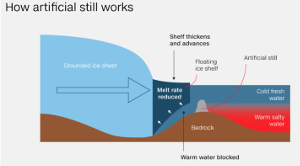|
Glacier Melt? Build a Seafloor Wall, Scientists Say
September 21, 2018
A group of scientists from Finland and the U.S. has proposed building seafloor walls to prevent glaciers from melting. The idea is to lump together vertical collections of rock and sand at the base of glaciers. That strategy is in part a response to what a 2016 Jet Propulsion Laboratory study named the main reason for a faster than anticipated rate of melt in the West Antarctica ice shelf: circulation of warm water beneath the ice. The theory is that the newly placed rock-and-sand walls, termed artificial stills, would act as a sort of seafloor bulwark and be tall enough to keep the warm salty water from rising above the top of the walls. The amount of ice melting from the West Antarctica ice sheet has increased by 70 percent just in the past 10 years, said a study in the journal Science. And when ice melts, it helps add to sea level rise, threatening low-lying areas around the world. In particular, the Thwaites glacier has been identified as a prime source of ice melt in the not too distant future; one estimate says that ice melt from this glacier could by itself increase global sea levels by several feet. Authors of the report were Michael Wolovick of Princeton University and the University of Lapland's John Moore. The report occurs in the late September issue of the journal Cryosphere, published by the European Geosciences Union. |
Social Studies for Kids |
Social Studies for Kids
copyright 2002–2019
David White





